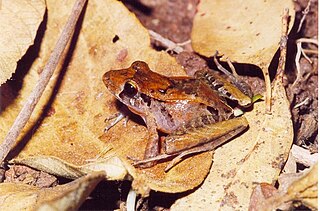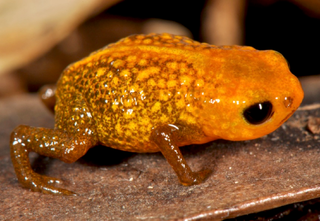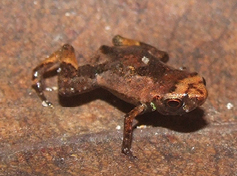
The saddleback toads (Brachycephalus) are a genus of tiny toads and frogs in the family Brachycephalidae in the order Anura, ranging from south Bahia to Santa Catarina in southeastern Brazil. The genus includes two main groups, the often brightly coloured pumpkin toadlets, and the overall brown and more frog-like flea frogs, which once were placed in their own genus Psyllophryne. Some pumpkin toadlets are toxic and their often bright colours are considered aposematic. At about 1 cm (0.4 in) or less in snout–to–vent length, the flea frogs are some of the smallest frogs in the world.

The Brachycephalidae are a family of frogs confined to eastern and southern Brazil and northern Argentina. The family is composed of two externally quite different genera: the tiny, often colourful and plump saddleback toads (Brachycephalus) from Brazil, and the larger, slimmer and more drab genus Ischnocnema from both Brazil and Argentina. The family is mainly defined by molecular characteristics, and are linked by few anatomical features. It was erected from two genera of the previously large family Eleutherodactylidae, which is now split into four families.

Adelophryne is a genus of frogs in the family Eleutherodactylidae. They are native to northern South America east of the Andes, known roughly from the area corresponding to the Guiana Shield, as well as to the coastal area of Bahia, Brazil. Whether the genus is truly distinct from Phyzelaphryne remains uncertain. Common name shield frogs has been proposed for this genus, although the stem flea frog is used for some species.

Euparkerella, sometimes known as Guanabara frogs, is a genus of frogs in the family Strabomantidae. They are endemic to the Atlantic coastal forests in the south-eastern Brazilian states of Espírito Santo and Rio de Janeiro. The name Euparkerella honours H. W. Parker, a herpetologist who named the type species, with the Greek prefix eu meaning true and suffix ella, a diminutive form.

Ischnocnema is a genus of frogs from eastern Brazil and north-eastern Argentina. They comprise the former Eleutherodactylus from this region, but they are closer to Brachycephalus than the "true" Eleutherodactylus. Consequently, they are now placed in their own genus Ischnocnema in the family Brachycephalidae.

Stumpffia is a genus of microhylid frogs that are endemic to Madagascar. They are mostly brown frogs that typically live among leaf litter. S. contumelia has a snout–vent length of about 8–9 mm (0.31–0.35 in), making it one of the world's smallest frogs, and several others in the genus are only slightly larger. The largest species is no more than 28 mm (1.1 in).

The pumpkin toadlet, or Spix's saddleback toad, is a small and brightly coloured species of frog in the family Brachycephalidae. This diurnal species is endemic to southeastern Brazil where it is found among leaf litter on the floor of Atlantic rainforests at an altitude of 200–1,250 m (660–4,100 ft). It is found in Espírito Santo, Rio de Janeiro, southeastern São Paulo and southeastern Minas Gerais. Although its type specimen supposedly was collected in Bahia about 200 years ago, there are no confirmed localities in this state and recent reviews consider it more likely that it was from Rio de Janeiro. B. ephippium is locally common, quite widespread compared to most other species of Brachycephalus and it is not considered threatened.

Brachycephalus nodoterga, also known as the Serra Cantareira saddleback toad, is a species of frog in the family Brachycephalidae. It is endemic to the eastern São Paulo state of southeastern Brazil, and only known from five locations in Atlantic rainforest at altitudes of 700–900 m (2,300–3,000 ft).
Brachycephalus ferruginus is a species of frogs in the family Brachycephalidae. It is endemic to southern Brazil and only known from its type locality, Pico Marumbi, in the Serra do Mar in Morretes, Paraná state. Its altitudinal range is 965–1,470 m (3,166–4,823 ft) above sea level.
Brachycephalus pombali is a species of frogs in the family Brachycephalidae. It is endemic to Brazil and only known from its type locality, "Morro dos Padres, Pico da Igreja", in the Serra do Mar in Guaratuba, Paraná state. The type locality is at about 1,300 m (4,300 ft) above sea level.
Eugênio Izecksohn was a Brazilian herpetologist. Izecksohn graduated from Universidade Federal Rural do Rio de Janeiro in 1953. Among others, he discovered and scientifically described the flea frog Brachycephalus didactylus, one of the smallest frogs in the world. Several taxa have been named in honour of him, mostly frogs like the tiny B. izecksohni, and the extremely rare—if not already extinct—Bokermannohyla izecksohni, but also a few from other groups like the fish Xenurolebias izecksohni and the bat Myotis izecksohni.

Brachycephalus mariaeterezae is a species of frog in the family Brachycephalidae. It is very tiny and was one of seven new species described by LF Ribeiro and a team of scientists from the Mater Natura - Instituto de Estudos Ambientais in Brazil. Like all species in its genus, it is found in a very small strip of Atlantic Forest in the southeastern coast of the country, and has a vibrant colour pattern. The speciation seen in this genus is thought to be a byproduct of the rift between the valley versus mountain terrain and its particular microclimates, to which they are adapted. It might be in population decline due to habitat loss. Its name honours Maria Tereza Jorge Pádua, a Brazilian environmentalist.

Brachycephalus olivaceus is a species of frog in the family Brachycephalidae. It is very tiny and was one of seven new species described by LF Ribeiro and a team of scientists from the Mater Natura - Instituto de Estudos Ambientais in Brazil. Like all species in its genus, it is found in a very small strip of Atlantic Forest in the southeastern coast of the country, and has a vibrant colour pattern. The speciation seen in this genus is thought to be a byproduct of the rift between the valley versus mountain terrain and its particular microclimates, to which they are adapted. It might be in population decline due to habitat loss. Its name derives from the Latin olivaceus, "olive-colored", in reference to its coloration.

Brachycephalus auroguttatus is a species of frog in the family Brachycephalidae. It is very tiny and was one of seven new species described by LF Ribeiro and a team of scientists from the Mater Natura - Instituto de Estudos Ambientais in Brazil. Like all species in its genus, it is found in a very small strip of Atlantic Forest in the southeastern coast of the country, and has a vibrant colour pattern. The speciation seen in this genus is thought to be a byproduct of the rift between the valley versus mountain terrain and its particular microclimates, to which they are adapted. It might be in population decline due to habitat loss. Its name comes from the Latin aurum for "gold" and gutta "drop" or "speck", in reference to golden spots found throughout the skin of this species.

Brachycephalus verrucosus is a species of frogs in the family Brachycephalidae. It is very tiny and was one of seven new species described by LF Ribeiro and a team of scientists from the Mater Natura - Instituto de Estudos Ambientais in Brazil. Like all species in its genus, it is found in a very small strip of Atlantic Forest in the southeastern coast of the country, and has a vibrant colour pattern. The speciation seen in this genus is thought to be a byproduct of the rift between the valley versus mountain terrain and its particular microclimates, to which they are adapted. It might be in population decline due to habitat loss. Its name is derived from the Latin verrucosus, "warty" or "rugged", alluding to the frogs highly rugose dorsum.

Brachycephalus fuscolineatus is a species of frog in the family Brachycephalidae. It is very tiny and was one of seven new species described by LF Ribeiro and a team of scientists from the Mater Natura - Instituto de Estudos Ambientais in Brazil. Like all species in its genus, it is found in a very small strip of Atlantic Forest in the southeastern coast of the country, and has a vibrant colour pattern. The speciation seen in this genus is thought to be a byproduct of the rift between the valley versus mountain terrain and its particular microclimates, to which they are adapted. It might be in population decline due to habitat loss.

Brachycephalus leopardus is a species of frog in the family Brachycephalidae. It is very tiny and was one of seven new species described by Luiz F. Ribeiro and a team of scientists from the Mater Natura — Instituto de Estudos Ambientais in Brazil. Like all species in its genus, it is found in a very small strip of Atlantic Forest in the southeastern coast of the country, and has a vibrant colour pattern. The speciation seen in this genus is thought to be a byproduct of the rift between the valley versus mountain terrain and its particular microclimates, to which they are adapted. It might be in population decline due to habitat loss. Its name derived from the Latin leopardus, referring to the frog's spotted pattern evocative of the felid genus Leopardus.

Brachycephalus boticario is a species of frog in the family Brachycephalidae. It is very tiny and was one of seven new species described by LF Ribeiro and a team of scientists from the Mater Natura - Instituto de Estudos Ambientais in Brazil. Like all species in its genus, it is found in a very small strip of Atlantic Forest in the southeastern coast of the country, and has a vibrant colour pattern. The speciation seen in this genus is thought to be a byproduct of the rift between the valley versus mountain terrain and its particular microclimates, to which they are adapted. It might be in population decline due to habitat loss. The species name pays homage to the Fundação Grupo Boticário de Proteção à Natureza, which partially funded the fieldwork of the study originally describing the frog.

Brachycephalus pitanga, the red pumpkin toadlet, is a small and brightly coloured species of anuran in the family Brachycephalidae. It is endemic to Atlantic rainforests in São Paulo state of southeastern Brazil, and only known from four localities at an altitude of 900–1,140 m (2,950–3,740 ft) in Ubatuba and São Luiz do Paraitinga. It can be very common where found, and two of the known localities are protected by the Serra do Mar State Park. Unlike many other pumpkin toadlets, the red pumpkin toadlet is not considered threatened.

Brachycephalus pulex, also known as the Brazilian flea toad and the Serra Bonita flea toad, is a species of small frogs in the family Brachycephalidae. It is one of more than 35 named species within the genus Brachycephalus. It has been suggested to represent the smallest known vertebrate, with an average snout–vent length of 7.10 millimetres (0.280 in) in mature males.


















